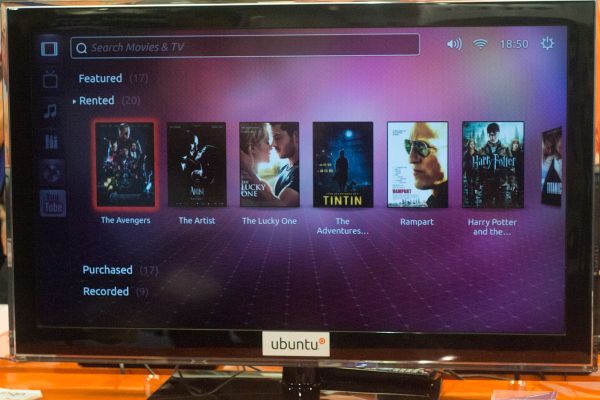Canonical Brings Ubuntu To Televisions
by Jason Inofuentes on January 12, 2012 9:28 AM ESTCanonical, a services and software company that backs open-source projects like Ubuntu, recently announced they would be moving to compete in the Smart TV space. The project, called Ubuntu TV, would be based on Ubuntu Linux and would be open-sourced, though the project is not targeted at DIYers like XBMC, rather it is aimed at manufacturers to integrate within the TV rather than as a set-top box. A lot of questions remained after the initial PR, so we were glad to talk to members of the team on the show floor, here at CES.
The demonstration unit Canonical had on the show floor is very much a mock-up, with limited functionality and mainly serving to demonstrate the UI paradigm. On the left is an array of icons relating to apps contained on the device and arranged vertically. Selecting the app from a remote or keyboard would reveal that apps interface, with the primary demonstration being a content store. A search function would provide either in-app contextual search or universal search depending on which screen you were in.
As a flavor of Ubuntu Linux, the end user would be able to install whatever Linux apps they please; accessing and using them from the TV optimized UI might pose a challenge, though. Custom UIs would obviously be a possibility, and community built applications for Ubuntu TV would be supported. But when we're talking content, a walled garden is always a necessity.
That's where Canonical comes in with their Ubuntu One platform. Unlike their Linux products, Ubuntu One is a closed-source client and server side solution that provides file and content distribution in a managed fashion. Though they didn't go into specifics, they would likely utilize an authorization based approach similar to Verizon FiOS' IPTV on Xbox 360 app. Users would purchase a television with a unique identifier, would register the device from their location with the content provider's service, and whenever they accessed their media, authorization would be verified through Ubuntu One. While the Linux community is not generally one to accept restrictions happily, some DRM is requisite in order to attract content providers and allow the platform to succeed.
We were assured several times, though, that the software platform (separate from the content management component) would be fully-open sourced. And though the Linux platform is capable of running on x86 or ARM-based hardware, Canonical expects shipping products to be based on ARM chipsets and sees optimization of the software on a particular hardware platform as a source of monetization, along with providing the DRM solution.
The Smart TV space is growing rapidly, and like 3D before it, will dominate the television market over the next several years. Unlike, 3D televisions though, the nitty gritty of these latest Smart TVs falls right in our bread and butter, so expect us to spend more time discussing and evaluating these devices as they make it to market.











2 Comments
View All Comments
sicofante - Friday, January 13, 2012 - link
I like Ubuntu and, unlike their mobility aspirations, I think they have a chance here. Android may be interesting for Smart TVs, but Ubuntu's Unity UI has its own advantages. Canonical is a smaller company and it should be easier for some manufacturers to reach an agreement with them rather than with Google.I definitely hope they succeed with this.
CaioRearte - Friday, January 13, 2012 - link
Hybrid Free/Non-Free solutions like these are exactly what the market needs. Although it's not the full freedom we want, hopefully someday at least hybrid software will be powering most devices, unlike the Micro$oft-powered world we have today.